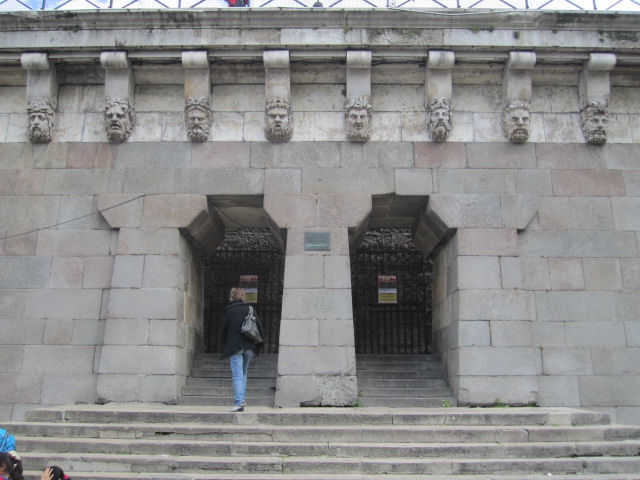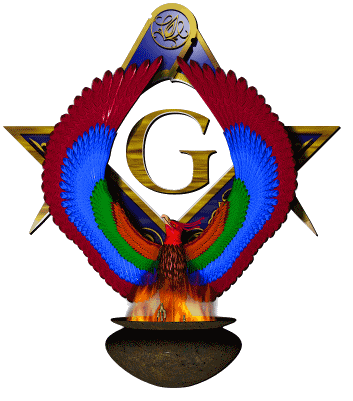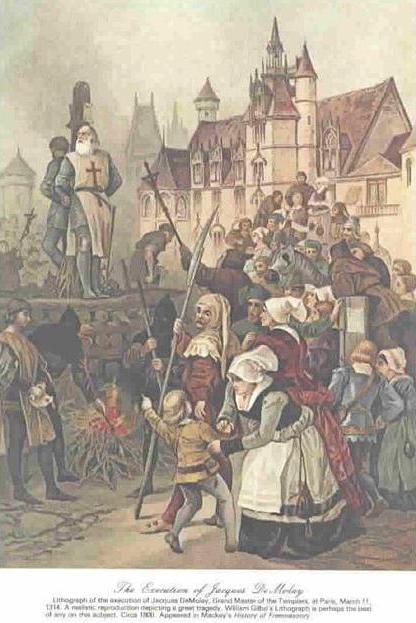Jacques de Molay
Last Grand Master of the Knights Templar
BY Lorne Pierce 32 degree
Past Assistant Grand Chaplain A.F.& A.M. OntarioThe origin of knighthood is lost in the dim past. In early England a knight seems to have been a youth who attended a member of the court; it was a position of honour and of service and might lead in time to Royal recognition and rank. In Germany the early knight may have been regarded much in the same way, a disciple. In both countries the knights were obviously ambitious and high-spirited youths as one might expect. It was in France, however, that the idea of chivalry arose, and this conception quickly spread throughout Europe. Some knights had made themselves useful to Earls or Bishops, that is the principal landlords and magnates and military chiefs of the realm, and might be classed as superior civil servants in times of peace, becoming leaders of the armies, both secular and religious, in times of war. There were, of course, many foot-loose knights wandering about Europe in quest of adventure, but on the whole a knight was a responsible link in the Feudal chain reaching from the king to the peasant. In time the ideal of chivalry came to prevail, and the high honour accompanying it seems to have derived from prehistoric Teutonic custom. The candidate had to submit to a rigorous investigation of his character and qualifications. Then the community turned out to welcome him with fitting ceremony and investiture with sword and shield, with belt and sword, or with gilt spurs and collar, usually by the knight's father or some exalted personage. In time t hose who had fought against the Saracens became preeminent, and were accorded rank and dignity independent of birth or wealth.
The Knights Templar, or Poor Fellow Soldiers of Christ and of the Temple of Solomon, was one of the three out-standing military orders of the Middle Ages in Christendom. The brotherhood was founded, about 1118, by Hugues de Payns, a nobleman residing near Troyes, in Burgundy, and Godefroy de St. Omer (or Aldemar), a
Norman knight. Their original purpose was to protect pilgrims to sacred places, more especially those who sought the Holy Sepulcher. At first there were eight or nine Knights Templar. They bound themselves to each other as a brotherhood in arms, and took upon themselves vows of chastity, obedience and poverty according to the rule of St. Benedict. It is also recorded that they pledged themselves to fight against ignorance, tyranny and the enemies of the Holy Sepulcher, and "to fight with a pure mind for the supreme and true King." Baldwin I, King of Jerusalem, assigned them accommodation in his palace, which stood on the site of the Temple of Solomon. In this way their name, Templars, was derived. At first the knights wore no uniform or regalia, nothing in fact save the cast-off garments that were given to them in charity. It was the poverty, sincerity and zeal of the order in its first years that endowed it with importance. They sought out the poor and the outcast, the excommunicated as well as the unwanted, and shepherded them within their fold.Hugues de Payns, accompanied by several of his knights, returned home in 1127 for the purpose of securing adequate ecclesiastical sanction for some of the special privileges which the order had usurped. Among the very special privileges was immunity from excommunication, which threatened a good deal of trouble. Bernard of Clairvaux, the greatest abbot of his day, received Hugues de Payns, and not only praised the Knights Templar, but went much further. The future St. Bernard did not attend the Council of Troyes in 1128, at which the Rule of the Temple was drawn up, but he seems to have inspired it - the constitution, ritual, discipline and very core of the order. Finally there got abroad the idea, that in the rule of the order there existed a "secret rule," and a legend speedily grew up around this "lost word." In time this was the undoing of the order. The whole Rule of the Temple was probably never written out, its more essential parts being conveyed by word of mouth, by symbol and sign, and protected by proper safeguards. The point of importance was, that the order now had ample acknowledgement and authority, and from this moment onward power and treasure flowed into its hands in an unending and broadening stream.
The Templars and the Crusades are forever associated in history and legend. The Templars, in an astonishingly short time, spread over Christendom. They had thousands of the fattest manors in the Christian world. They became the bankers of the age, the money exchange between Europe and the East, the trust company of the time. They provided loans to princes, dowries for queens, ransoms for great warriors, safety deposit vaults for the treasure of emperors and popes. Their chapters were the schools of diplomacy of the time, training grounds for prospective rulers, colleges in commerce and finance, sanctuaries for all who needed protection, high or low. It was inevitable that they should attract to themselves the envy of the less fortunate orders and guilds. In time, in fact before the death of St. Bernard, in 1153, they had not only received the tribute of kings and cardinals in the form of lands and treasure, but they freed themselves from the necessity of paying tax, tithe or tribute to any power, prince or pope, which privilege they claimed as defender of the Church. This was enough to bring upon themselves the inevitable reckoning for overreaching ambition, but they went further, very much further. They not only claimed exemption from excommunication, but claimed exemption from all papal decrees except those specially aimed at them by name, and they owed allegiance to no power or authority on earth except their own head, the Bishop of Rome. They had become a separate social, economic, political and religious order, cutting across and transcending kingdoms, principalities and archdioceses, with only the Vice-gerent of God superior to their Grand Master. The enormous powers of the Knights Templar were bound to be challenged by the popes as well as kings who demanded loyalty within their realms. The order found itself in increasingly compromising situations, the victim of treachery on the part of kings and princes of the Church, or the instigator of trickery and subterfuge on its own part to preserve its powers. The King of France, Philip the Fair, set out to unite the Hospitallers and the Templars into one grand order, The Knights of Jerusalem, the Grand Master of which was always to be a prince of the royal house of France. The Grand Master of the Knights Templar invariably was Master of the Templars at Jerusalem, and in Cyprus after the loss of the Holy Land to the Turks. He came in time to live in a sumptuous manner, befitting his great wealth and vast powers. In th e field, during the campaigns, he occupied a great tent, round, with the black and white pennant flying above its high peak, bearing the red cross of the Templars. Regional Grand Commanders were accorded similar honours and no one took precedence over them except the Grand Master, when he was present.
We know little concerning the initiation ceremonies of the Knights Templar. Probably there was some cleansing ritual, robing in white, the all-night vigil and Holy Communion, gilt spurs, sword or other gift of honour, and finally the oath and accolade. Certainly the order was a Christian institution. Their war-cry Beauseant! - also inscribed on their banners and pennants, pledged loyalty to their friends and promised terror to their foes. Likewise both a prayer and a pledge were the well-known words:
Non nobis, Domine, non nobis, sed nomini tuo da gloriam.
(Not unto us, O Lord, not unto us, but unto Thy Name be the glory.)
Jacques de Molay was the twenty-second and last Grand Master of the Knights Templar. He was born about 1240 at Besancon, in the Duchy of Burgundy, and was of noble but poor family. He was admitted to the order of knighthood, in 1265, at Beaune and proceeded shortly to the Holy Land, under the Grand Master William de Beaujeu, to fight for the Holy Sepulcher. Jacques de Molay remained in the Holy Land for many years, for he was still with the order in Jerusalem when, about 1295, he was elected Grand Master upon the death of Grand Master Gaudinius - Theobald de Gaudilai. After the loss of Palestine by the Templars, de Molay took his few remaining knights to the Island of Cyprus. In 1305 he was summoned to a conference with the Pope, Clement V, who stated that he wished to consider measures for effecting a union between the rival Templars and Hospitallers. A long and bitter feud had existed between the two great orders. However, both had agreed not to accept disciplined members who might desire to transfer their allegiance from one order to the other. Also, in battle, it was permitted members who became hopelessly separated from the main body of one order to rally under the cross of the rival order if near.
Jacques de Molay, accompanied by sixty knights, made a royal progress westward. He called upon the Pope who consulted him regarding a further Crusade, and de Molay requested an investigation into charges that were already being openly made against the order. Finally he arrived in Paris with kingly pomp. Philip the Fair, King of France, suddenly arrested every Knight Templar in France, October 13, 1307, de Molay and his sixty friends among them. They were brought before the University of Paris and the charges read to them. De Molay spent five and a half years in prison. Of those arrested, one hundred and twenty-three knights of the order "confessed under the torture of the Inquisition." Some confessed that at the initiation ceremonies they had spat upon the Crucifix. When the Grand Master's turn came he likewise confessed, apparently to bogus charges prepared beforehand by the Inquisition, fearing torture, but he denied the charges of gross practices indignantly, and demanded audience with the Pope. The Pope himself believed the Templers were guilty, at least on some of the counts, but he resented the intrusion of Philip in what he regarded as his own special precinct, in spite of the fact that he largely owed his papal tiara to Philip.
Many retracted their confessions regarding their indignity to the Crucifix, only to be burned at the stake. Many who returned to their homes throughout Christendom, recanted, but the Inquisition followed them and they burned. Despotism, naked and cruel, without scruple or any capacity for shame, had broken loose upon the world. It was a new and bloody technique that proved vastly effective in the hands of tyrants - both secular and religious. Civilization
was to hear a good deal about this arbitrary rule, this summary and vindictive totalitarianism, without conscience, hungry for power, wholly wicked, completely mad. In 1311, Clement and Philip became reconciled, which prepared the way for the final act in the tragedy. The next year, at Vienna, the Pope condemned the order in a sermon while Philip sat at his right hand. Later the inevitable occurred; the Knights Templar were broken up. Much of their treasure was given to the Knights of St. John, but Philip the Fair and Clement V reserved land and treasure, castles and Abbeys for themselves and their friends.No full hearing seems to have been given to all the charges, or any comprehensive judgment handed down on the order as a whole. However, in 1314, Jacques de Molay, whose fear had made him a pathetic figure, and whose craven "confessions" contrary to the oath of his order had sent hundreds to their death, again confessed, again recanted his confession, again confessed, each time shrinking miserably in stature both as a man and Grand Master and having humiliation and utter disgrace heaped upon him for his pa ins. Finally, after the long imprisonment and tragedy and sorrow of it all, he was led out upon the scaffold in front of Notre Dame in Paris, in company with his friend Gaufrid de Charney, Preceptor of Normandy. The papal legates were in attendance and a vast multitude of people filled the square. He was to confess by arrangement and hear the legates sentence him to life imprisonment. Jacques de Molay finally atoned. Instead of confessing he proclaimed the innocence of the order. King Philip the Fair did not hesitate or consult with the Pope's legates; he had de Molay burned forthwith, "between the Augustinians and the royal garden." Guido Delphini was burned with them, and also the young son of the dauphin of Auvergne. With his dying breath Jacques de Molay shouted to the multitude that King and Pope would soon meet him before the judgment seat of God. The common people gathered up his ashes, and before many days it was as de Molay had foretold, Both Clement V and Philip the Fair were dead.
The immortal Dante maintained the innocence of the Knights as did many another famous contemporary. Today it is generally admitted that the Inquisition went to the poor knights in prison, told them that their officers had confessed to spitting upon the Crucifix, and then wrung from them "confessions" by the most brutal of all institutions. The confessions are all discounted. The evidence against them was from their rivals, the Dominicans and Franciscans and others, all worthless.
The Order had long held the Turk in check, and kept alive the dream of a united Christendom. It had given to the world the idea of the chivalrous man as a religious man, the servant of his state not ashamed to own his God. It had paved the way for the large part laymen were to play in the religious life of the nations. It was the school of diplomacy and commerce, of international finance and opinion. Those who destroyed the order opened the way for Turkish conquests in the West. They also made known the horrors of despotism, of trial by pogrom and purge, which kindled again in the wicked days of St. Bartholomew's and in the mad days of the French Revolution - the cult of cruelty, that ran its course even in the New World with witch hunts and burnings, and that is not yet dead. It has been said that the thirteenth of October, 1307, was a day of humiliation for the whole race. If the world remembers, and recovers its sense of shame, its capacity for indignation, it may not have been in vain.
The Middle Ages were past, and deep rivers of Christian blood had flowed for two hundred and fifty years, before the Turk was expelled from the Spanish peninsula. Under Don John of Austria the Mediterranean states, organized into a league, sent an armada of two hundred ships against the Turkish fleet that had sailed westward from Cyprus and Crete. Christian met Saracen off Lepanto, October 7, 1571, broke the naval power of the Turks forever and set barricades to their western expansion to this day. Thus was October 13, 1307, at last avenged. Nearly every European state and noble family was represented. There was also present a humble Spaniard who had his arm shattered but who lived to write a book, with his one good hand, the novel Don Quixote, that laughed the last dregs of a corrupt and bogus chivalry out of Europe. He died in 1616, the year our Shakespeare died, and an era ended. The era of the common man followed; a new day had dawned.
Below are some shots of the Jacques Demolay commemorative plaque. It is at the
western tip of the Il de la Cite, which is an island in the middle of the
Seine where Nortre Dame is located. The plaque is on the side of a bridge
called Pont de Neuf - oldest bridge in Paris dating to early 1600s. There is
a splendid little park here (pictured above), but in 1314 it would have been the middle of
the river. It is believed that the pyre was set up in the middle of the river where he
was burned at the stake.

It roughly translates to:
On this location
Jacques Demolay
Last Grand Master
of the Order of the Temple
was burned in the summer on March 18, 1314
![]()

